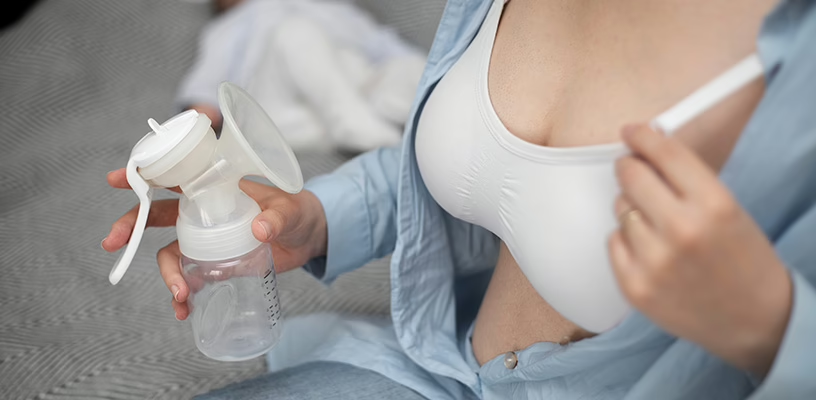Power Pumping: A Guide to Boosting Your Breast Milk Supply
Despite becoming a pro at this whole breastfeeding thing, you might feel depleted by the constant demands of your ever-hungry bundle of joy. Power pumping could be what you need to boost your milk supply without losing your mind.

Power pumping works by making your body think it needs to ramp up its breast milk production.
Whether you’re looking to increase your supply before even leaving the hospital or you’ve already gotten home and have discovered your baby has a bottomless pit for a stomach, here’s all you need to know about power pumping.
What is power pumping?
Power pumping, also known as cluster pumping, means using a breast pump to mimic the suckling cues your baby naturally gives when he’s in cluster-feeding mode (i.e., frequent feeding for short bursts).
The idea is simple: emptying your breasts more often equals more milk production. It sends a message to your body that it’s time to step things up. 1
Why you might consider power pumping
There are plenty of reasons you may want to try power pumping, including:
- Persistent low supply: You’ve tried other ways to increase your milk output with no success.
- Future-proofing: You want to stock up on your breast milk and build a freezer stash.
- Returning to work: You want to maintain your supply (and production) while you’re at work.
- Relactation: You need to get going again with your breastfeeding after a weaning period.
- Starting solids: If your baby’s switching to solids with spoon-feeding or finger foods (e.g., if you’re trying a strategy like baby-led weaning), you may still want to maintain your milk supply until the transition is complete.
Before you pop on the pump, do a little research (reading this article is a great start!), and consider asking your doctor or a lactation consultant (LC) whether this method is right for you.
Pumping doesn’t have to replace “normal” breastfeeding
Breastfeeding often and on demand is still the best option for your baby. However, if he isn’t nursing as much or you’re facing a production dip, power pumping can be a complement to breastfeeding and is a decent solution.
When to avoid power pumping
Pumping shouldn’t hurt. If it does, stop what you’re doing and have a LC look at your pump to ensure it fits properly.
Also, be cautious about power pumping if you haven’t actually given birth yet. Frequent pumping can stimulate uterine contractions in expectant mothers, so ask your doctor about it before you start. 2
Some conditions can affect your milk supply
Certain medical issues can reduce your milk supply, like thyroid conditions, diabetes, or a postpartum hemorrhage. You may still be able to power pump even with these conditions, but defer to your doctor’s advice. They may want to prescribe other treatments if your milk production has declined due to a health problem.
How power pumping works: setting a schedule
With power pumping, you’ll pump in shorter, more frequent sessions (often over the course of an hour) instead of pumping once every few hours.
Here are a few sample schedules: 3
- Option 1: Pump for 20 minutes to start with and switch between 10-minute rests and 10-minute pumps for the remainder of the hour.
- Option 2: Alternate between 10-minute rests and 10-minute pumps for the entire hour.
- Option 3: Pump twice per day for 30 minutes (pump for 10 minutes, rest for 10 minutes, then pump for another 10).
Most women find that their milk supply is higher in the morning, so you’ll likely be able to produce more then. 4
The key to any power pumping schedule is consistency. After your session, you can go back to nursing like normal for the rest of the day.
Make sure to choose the best breast pump for your needs. For example, a double electric pump (rather than a manual one) gives you the most milk by pumping both breasts simultaneously. Some moms also invest in a secondary wearable breast pump so that they can still pump while multitasking while they’re on the go.
More frequent power pumping sessions can increase milk production, but you should check with your doctor first to see if it’s necessary.
What to expect and when to see results
Many moms see a supply bump within 4 to 7 days, while others need more time to get things flowing. Be patient, and don’t give up too quickly. Track your milk output to stay motivated, and reach out to your doctor or LC if you have concerns or questions. 3
A note on hygiene and storage
Always use a clean pump kit. Break down the pump and rinse off any tubes or individual parts that touch the breast or milk, like the flanges (funnels), collection bottles, and membranes. Trash anything moldy or damaged.
Breast milk storage is also important. Seal your milk up tight, and use date and time labels for storage in the refrigerator or freezer. 5
You can even keep a digital log of you stash and pumping sessions in your baby tracker app for easy reference.
Getting the most out of your power pumping sessions
Power pumping can be draining in more ways than one, so here are a few tips to settle you in and make the most of your sessions:
- Hydration is king: You’ll need to drink more water than usual. Start with at least 8 cups per day.
- Eat well: Don’t skip meals and snacks. Healthy fats, proteins, fresh vegetables, and whole grains should all be part of your breastfeeding diet. 6
- Get support: Have someone take charge of your little one so you can pump without distractions. Getting plenty of rest beforehand also makes pumping less taxing.
- Trigger “let-down”: This is the hormone-activated reflex that gets your breast milk moving. Help kickstart the flow by looking at pictures or videos of your baby, smelling your baby’s clothing or blanket, applying a warm compress to your breasts, or gently massaging your breasts. 7
- Inspect your pump: Make sure your pump is working correctly and that the flanges fit properly. Also, try applying a little lubricant to the inner edge of the flanges (or to your skin, where it comes into contact with them) to cut down on pump friction.
- Make it enjoyable: Catch up on that one Netflix show, read a book, or listen to music so those pumping sessions aren’t too tedious.
Final thoughts
If you do it right, power pumping can be a game-changer. Congratulate yourself if your refrigerator is filled to the brim with that liquid gold of yours—and if not, cut yourself some slack and take heart in knowing that no solution is one-size-fits-all.
Article Sources
- Tallahassee Memorial HealthCare. "Breastfeeding: A Guide to Optimizing Your Milk Supply" Retrieved July 11, 2025.
- American College of Obstetricians and Gynecologists. "8 Questions to Ask Your Doctor Before Labor Induction" Retrieved July 11, 2025.
- The Fed Is Best Foundation. "Power Pumping: Does it Work?" Retrieved July 11, 2025.
- Virtua Health. "How to Start Pumping, Bottle Feeding, and Storing Breastmilk" Retrieved July 11, 2025.
- U.S. Centers for Disease Control and Prevention. "How to Clean and Sanitize Breast Pumps" Retrieved July 11, 2025.
- Office of Disease Prevention and Health Promotion. "Eat Healthy While Breastfeeding: Quick Tips" Retrieved July 11, 2025.
- University of Utah Health. "How to Let-Down and Strategies for New Mothers to Breast Pump at Work" Retrieved July 11, 2025.







